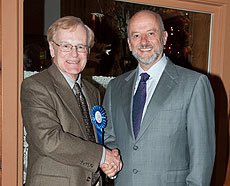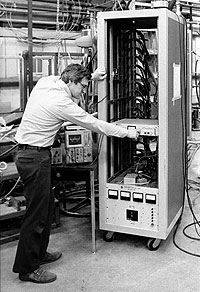Electrical engineer Ray Yarema retires after more than 40 years
 |
| Ray Yarema poses with Fermilab Director Pier Oddone after receiving the 40 Year Service Award on October 28, 2010. Photo: Reidar Hahn |
Ray Yarema came to Fermilab in 1970 when the lab was under construction and employees traveled muddy roads to sit in dusty offices working on typewriters. He started off designing power electronics for the accelerator complex, which are still in use today.
He couldn’t have imagined how technology would’ve advanced in just four decades— or that he would still be here.
Today, he leaves behind some big shoes to fill in the Particle Physics Division’s Electrical Engineering Department, where he has led the application-specific integrated circuit (ASIC) design group he founded in the late ‘80s.
Tom Zimmerman, a Fermilab electrical engineer who has worked for Yarema since 1984, said he has the unique ability to identify promising technologies.
"He's a visionary," Zimmerman said. "He founded the ASIC design group at Fermilab because he saw that integrated circuit technology was an important development that could be of great benefit to the lab."
In the ASIC group’s early days, Yarema led the development of 2D integrated circuits, small silicon chips loaded with thousands to millions of transistors that are used to detect and track particles in collision detectors, including both CDF and DZero. Although it was a new technology in high-energy physics back then, ASICs now play a vital role in virtually every large high-energy physics experiment.
Most recently, Yarema led a team of engineers in the design of the first 3D integrated circuit for high-energy physics. Providing a higher density of electronics per area, 3D circuits could help revolutionize the field of electronics for high-energy physics by making future particle detectors lighter, more concise and more energy-efficient.
“He spearheaded what is now a worldwide collaboration in this field,” said Zimmerman, referring to an international consortium of sixteen institutions that Yarema organized to advance the development of 3D integrated circuits for physics experiments.
“I have to say, Ray is the ideal boss,” Zimmerman said. “I consider him my mentor—any time I run into a problem, I can always count on his sound advice. I’ll miss that.”
Yarema’s leadership roles also included serving as head of the Electrical Engineering Department for seven years until August 2008.
Read more
— Christine Herman
 |
| Ray Yarema works on a piece of equipment known as a dipole regulator in 1980, which runs in the main accelerator to this day. Photo: Fermilab. |
|